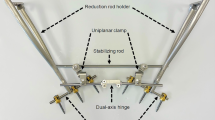Abstract
Background
Pedicle screw misplacement is a common complication, while 7% may result in neurological complications. Computer-assisted navigation improves the rate of ideally placed screws. Inappropriate reference marker attachment can cause major problems in the outcome and duration of surgery.
Objective
To improve fixation of reference bases by comparing different designs of spine clamps and measuring their stability against the relevant thoracic and lumbar anatomy.
Methods
Force needed to dislocate the clamp from the processus spinosus using defined fixation of 0.79, 0.90 and 1.02 Nm torque was evaluated. Force transmission from clamp to the processus spinosus was also examined. Artificial thoracic and lumbar vertebral bodies were used for attaching spine clamps of three different designs. An instrument transmitted linear force onto the reference clamp and recorded the force when dislocation occurred. Another device determined transmitted force for each clamp utilizing 0.79, 0.90, 1.02, 1.13 and 1.24 Nm torque.
Results
L-clamp had the most stable fixation in lumbar section for every torque and developed the greatest forces. These transmitted forces were similar to the less stable Y-design. I-design created the smallest forces and had the most stable fixation for thoracic spine. The Y- and the L-design caused a notably high number of fractures.
Conclusion
Great force leads to great stability, but also creates more fractures, favoring the use of smaller forces. Specific anatomy adaptation is important. Different clamp designs create different forces, while still differing in stability depending on their application in the thoracic or the lumbar spine.









Similar content being viewed by others
References
Amiot LP, Lang K, Putzier M, Zippel H, Labelle H (2000) Comparative results between conventional and computer-assisted pedicle screw installation in the thoracic, lumbar, and sacral spine. Spine 25:606–614
Citak M, Board TN, Sun Y, Look V, Krettek C, Hufner T, Kendoff D (2007) Reference marker stability in computer aided orthopedic surgery: a biomechanical study in artificial bone and cadavers. Technol Health Care 15:407–414
Citak M, Haasper C, Kendoff D, Geerling J, Ortega G, Krettek C, Kfuri M, Hufner T (2006) Preliminary clinical experience using a newly developed minimal-invasive reference base in computer assisted foot surgery. Technol Health Care 14:515–519
Dickman CA, Yahiro MA, Lu HT, Melkerson MN (1994) Surgical treatment alternatives for fixation of unstable fractures of the thoracic and lumbar spine. A meta-analysis. Spine 19:2266S–2273S
Ebraheim NA, Xu R, Ahmad M, Yeasting RA (1997) Projection of the thoracic pedicle and its morphometric analysis. Spine 22:233–238
Esses SI, Sachs BL, Dreyzin V (1993) Complications associated with the technique of pedicle screw fixation. A selected survey of ABS members. Spine 18:2231–2238 discussion 2238-9
Jerosch J, Malms J, Castro WH, Wagner R, Wiesner L (1992) Accuracy of pedicle screws following instrumented dorsal fusion of the lumbar spine. Z Orthop Ihre Grenzgeb 130:479–483
Laine T, Lund T, Ylikoski M, Lohikoski J, Schlenzka D (2000) Accuracy of pedicle screw insertion with and without computer assistance: a randomised controlled clinical study in 100 consecutive patients. Eur Spine J 9:235–240
Ludwig SC, Kramer DL, Balderston RA, Vaccaro AR, Foley KF, Albert TJ (2000) Placement of pedicle screws in the human cadaveric cervical spine: comparative accuracy of three techniques. Spine 25:1655–1667
Mayr E, de la Barrera JL, Eller G, Bach C, Nogler M (2006) The effect of fixation and location on the stability of the markers in navigated total hip arthroplasty: a cadaver study. J Bone Joint Surg Br 88:168–172
Nolte LP, Steffen R, Kramer J, Jergas M (1993) Fixateur interne: a comparative biomechanical study of various systems. Aktuelle Traumatol 23:20–26
Ohnsorge JA, Weisskopf M, Siebert CH (2005) epiDRB–a new minimally invasive concept for referencing in the field of computer-assisted orthopaedic surgery. Z Orthop Ihre Grenzgeb 143:316–322
Rampersaud YR, Simon DA, Foley KT (2001) Accuracy requirements for image-guided spinal pedicle screw placement. Spine 26:352–359
Roy-Camille R, Roy-Camille M, Demeulenaere C (1970) Osteosynthesis of dorsal, lumbar, and lumbosacral spine with metallic plates screwed into vertebral pedicles and articular apophyses. Presse Med 78:1447–1448
Vaccaro AR, Rizzolo SJ, Balderston RA, Allardyce TJ, Garfin SR, Dolinskas C, An HS (1995) Placement of pedicle screws in the thoracic spine. Part II: an anatomical and radiographic assessment. J Bone Joint Surg Am 77:1200–1206
Vahldiek MJ, Panjabi MM (1998) Stability potential of spinal instrumentations in tumor vertebral body replacement surgery. Spine 23:543–550
Yuan HA, Garfin SR, Dickman CA, Mardjetko SM (1994) A historical cohort study of pedicle screw fixation in thoracic, lumbar, and sacral spinal fusions. Spine 19:2279S–2296S
Acknowledgments
No scientific or financial outside support was received for this study.
Author information
Authors and Affiliations
Corresponding author
Rights and permissions
About this article
Cite this article
Uksul, N., Suero, E.M., Stübig, T. et al. Mechanical stability analysis of reference clamp fixation in computer-assisted spine surgery. Arch Orthop Trauma Surg 131, 963–968 (2011). https://doi.org/10.1007/s00402-010-1252-7
Received:
Published:
Issue Date:
DOI: https://doi.org/10.1007/s00402-010-1252-7




